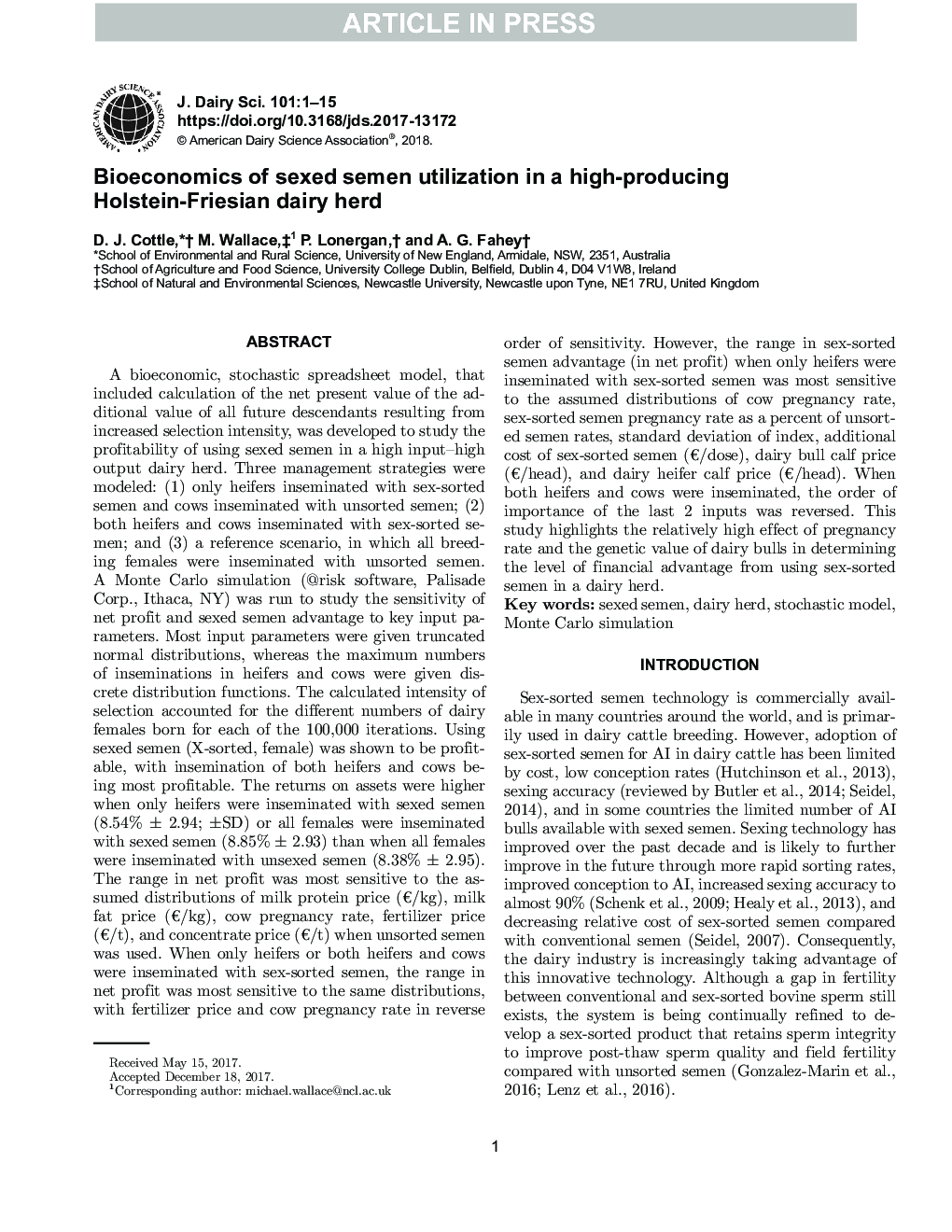| کد مقاله | کد نشریه | سال انتشار | مقاله انگلیسی | نسخه تمام متن |
|---|---|---|---|---|
| 8501395 | 1553840 | 2018 | 15 صفحه PDF | دانلود رایگان |
عنوان انگلیسی مقاله ISI
Bioeconomics of sexed semen utilization in a high-producing Holstein-Friesian dairy herd
ترجمه فارسی عنوان
اقتصاد بیرونی از استفاده از اسپرم جنس در یک گاو شیری تولید شده از هولشتاین-فریزیان بالا
دانلود مقاله + سفارش ترجمه
دانلود مقاله ISI انگلیسی
رایگان برای ایرانیان
کلمات کلیدی
منی جنسی گاو شیری، مدل تصادفی شبیه سازی مونت کارلو،
موضوعات مرتبط
علوم زیستی و بیوفناوری
علوم کشاورزی و بیولوژیک
علوم دامی و جانورشناسی
چکیده انگلیسی
A bioeconomic, stochastic spreadsheet model, that included calculation of the net present value of the additional value of all future descendants resulting from increased selection intensity, was developed to study the profitability of using sexed semen in a high input-high output dairy herd. Three management strategies were modeled: (1) only heifers inseminated with sex-sorted semen and cows inseminated with unsorted semen; (2) both heifers and cows inseminated with sex-sorted semen; and (3) a reference scenario, in which all breeding females were inseminated with unsorted semen. A Monte Carlo simulation (@risk software, Palisade Corp., Ithaca, NY) was run to study the sensitivity of net profit and sexed semen advantage to key input parameters. Most input parameters were given truncated normal distributions, whereas the maximum numbers of inseminations in heifers and cows were given discrete distribution functions. The calculated intensity of selection accounted for the different numbers of dairy females born for each of the 100,000 iterations. Using sexed semen (X-sorted, female) was shown to be profitable, with insemination of both heifers and cows being most profitable. The returns on assets were higher when only heifers were inseminated with sexed semen (8.54% ± 2.94; ±SD) or all females were inseminated with sexed semen (8.85% ± 2.93) than when all females were inseminated with unsexed semen (8.38% ± 2.95). The range in net profit was most sensitive to the assumed distributions of milk protein price (â¬/kg), milk fat price (â¬/kg), cow pregnancy rate, fertilizer price (â¬/t), and concentrate price (â¬/t) when unsorted semen was used. When only heifers or both heifers and cows were inseminated with sex-sorted semen, the range in net profit was most sensitive to the same distributions, with fertilizer price and cow pregnancy rate in reverse order of sensitivity. However, the range in sex-sorted semen advantage (in net profit) when only heifers were inseminated with sex-sorted semen was most sensitive to the assumed distributions of cow pregnancy rate, sex-sorted semen pregnancy rate as a percent of unsorted semen rates, standard deviation of index, additional cost of sex-sorted semen (â¬/dose), dairy bull calf price (â¬/head), and dairy heifer calf price (â¬/head). When both heifers and cows were inseminated, the order of importance of the last 2 inputs was reversed. This study highlights the relatively high effect of pregnancy rate and the genetic value of dairy bulls in determining the level of financial advantage from using sex-sorted semen in a dairy herd.
ناشر
Database: Elsevier - ScienceDirect (ساینس دایرکت)
Journal: Journal of Dairy Science - Volume 101, Issue 5, May 2018, Pages 4498-4512
Journal: Journal of Dairy Science - Volume 101, Issue 5, May 2018, Pages 4498-4512
نویسندگان
D.J. Cottle, M. Wallace, P. Lonergan, A.G. Fahey,
